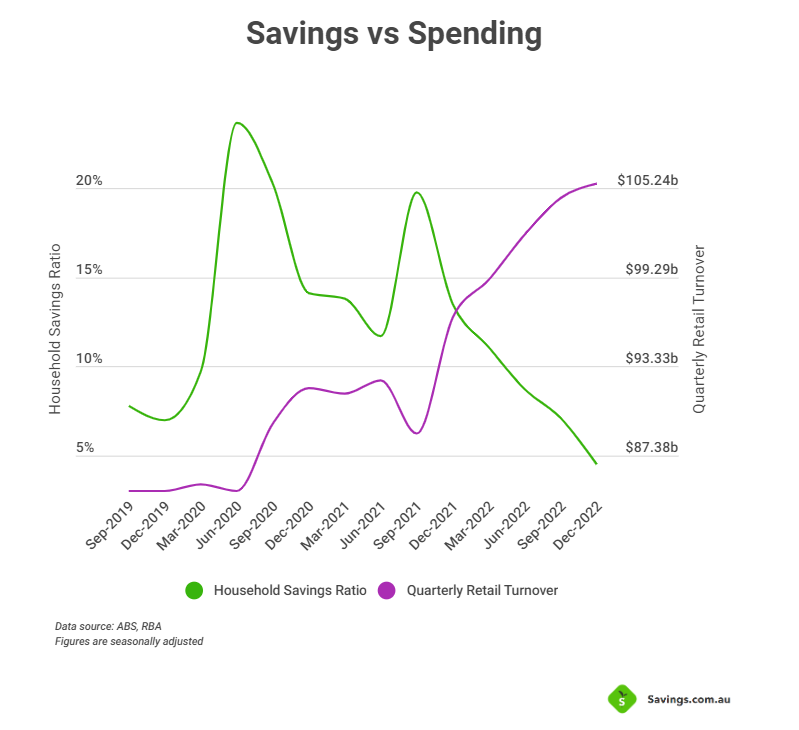February’s increase follows a 1.8% rise in January 2023 as Aussies sought to make the most out of the summer holidays.
Key points
- Retail sales lifted a modest 0.2% in February, driven by spending in department stores and cafes, restaurants, and takeway services.
- The weaker than expected data signals households are starting to feel the pressure of rising interest rates.
- The soft data could point to a rate hike in April, however February CPI data released tomorrow will provide a better outlook as to whether the RBA holds or not.
- Leading the charge was spending in department stores, increasing 1% from January, followed by the categories of clothing, footwear and personal accessory retailing lifting 0.6% and cafes, restaurants, and takeaway services up 0.5%.
Market consensus was broadly in line with expectations, while major bank economists pencilled in expectations ranging from -0.3% to +0.5%.
- NAB: 0.0%
- Westpac: +0.5%
- ANZ: +0.4%
- CBA: -0.3%
The weaker than expected data sends a signal households are struggling under the weight of soaring interest rates and a big rise in the cost of living.
ABS Head of Retail Statistics Ben Dorber noted retail sales appear to have levelled out after a period of increased volatility over November, December, and January.
“On average, retail spending has been flat through the end of 2022 and to begin the new year,” Mr Dorber said.
“Spending in food related industries continued to grow steadily in February, with cafes, restaurants and takeaway food services up 0.5%, while food retailing rose 0.2%.
“Non-food industry results were mixed as consumers continue to pull back on discretionary spending in response to high cost of living pressures.”
Across the states and territories, retail turnover rose modestly (1% or less) while Queensland recorded the only fall in turnover, down 0.4%.
Overall, retail turnover was up 6.4% compared to this time last year.
Westpac Senior Economist Matthew Hassan said the important point to remember is the volatile monthly profile leading to February’s data.
“Sales posted a steep 3.9% drop in December and only a partial 1.8% rebound in January,” Mr Hassan said.
“This means that February was always likely to post a month to month gain but that this conceals a material underlying weakening in sales on a 3 month basis.
“Indeed, sales are down 1.5% quarter on a rolling 3 month basis (i.e. Dec-Jan-Feb vs Sep-Oct-Nov).”
CommBank Senior Economist Belinda Allen expects consumer spending to continue to moderate as the impact of rate hikes intensifies.
“Together with negative real wages growth, this will impact households’ available cash flows,” Ms Allen said.
“Our internal CBA card spend data to 24 March shows a continued moderation in the annual pace of spending growth.
“There has been particular weakness in household goods spending while recreation spend is moderating from very strong levels over the holiday period. Our data is broader than just retail and is an indicator of overall household spending.”
To be or not to be? Will the RBA pause given the retail data
The modest rise in retail sales lends itself to the idea the RBA could pause interest rate hikes at the upcoming 4 April meeting.
The minutes from the March meeting revealed retail sales figures (along with other key data sets) would be important in weighing the central bank’s policy options in April, including a possible rate pause.
“Members agreed to reconsider the case for a pause at the following meeting, recognising that pausing would allow additional time to reassess the outlook for the economy,” the RBA minutes said.
“At what point it will be appropriate to pause will be determined by the data and the board’s assessment of the outlook.”
With monthly inflation data released tomorrow, which is also viewed closely by the RBA, the board will have all the ingredients needed to determine whether a rate hike is necessary next week.
CommBank expects monthly inflation to decreased by 0.5 percentage points at an annualised rate - down from 7.4% to 6.9% - and will finalise its April RBA call after the print is released on Wednesday.
Last week, Westpac Chief Economist Bill Evans said he expects the RBA to pause in April despite waiting on the release of retail trade and February’s monthly inflation figure.
“Westpac is skeptical and expects the monthly indicator to lift again, by 0.6% in February, with the January update overstating the extent of slowing,” Mr Evans said.
“Despite the better than anticipated employment report, we expect the risks around financial market developments and the evidence of the soft data since the February Board meeting will prompt the RBA to use its ‘pause option’ in April.”
More to come…
"Soft retail sales figures point to possible rate pause at April's RBA meeting" was originally published on Savings.com.au and was republished with permission.
